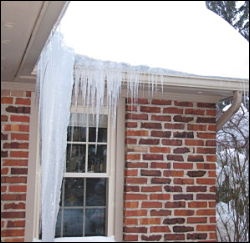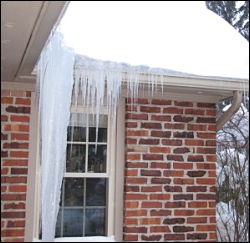 December 2010 set records for snowfall in Central New York. Along with lake effect snows, there have been periods of thawing and refreezing causing problems for homeowners by creating ice dams - ridges of ice that prevent melting water from draining off the roof. Ice dams cause water ponds on roofs which can back up under shingles, seep into insulation and leak into the attic or along exterior walls. This water infiltration can lead to mold, mildew, interior wall/ceiling damage and rot.
December 2010 set records for snowfall in Central New York. Along with lake effect snows, there have been periods of thawing and refreezing causing problems for homeowners by creating ice dams - ridges of ice that prevent melting water from draining off the roof. Ice dams cause water ponds on roofs which can back up under shingles, seep into insulation and leak into the attic or along exterior walls. This water infiltration can lead to mold, mildew, interior wall/ceiling damage and rot.
What causes ice dams to form on roofs? Homes with sloping roofs are particularly susceptible to ice dams. For ice dams to form there must be snow on the roof. At the same time, the higher sections of the roof must warm to over 32 degrees while the lower sections of the roof must have temperatures below 32 degrees. The snow on the upper section of the roof melts and as it flows down, it refreezes. The most common cause of these temperature variations is inadequate insulation and/or ventilation. Exhaust systems in the kitchen or bathroom that emit heat just above the roof may also contribute to snow melts as do chimneys, wood stoves, fireplaces and recessed lights when they are in frequent use.
Another common problem during winter months is condensation of water vapor on cold surfaces in attics. Condensation occurs when warm air from the living space below rises into the attic. High humidity levels in the living space also contribute to condensation in the attic. Condensation on wood surfaces can lead to mold, mildew and rotted wood.
Taking the following steps can help prevent ice dams and condensation from occurring:
- Remove snow from the roof. A “roof rake” may be helpful for some homes.
- Increase insulation and seal air leaks to create a barrier to prevent warm, moist air from infiltrating the attic.
- Provide good attic ventilation to replace warm air in the attic with cold air from the outside.
- Clear leaves and debris from gutters. While this will not prevent ice dams on the roof, clear gutters can divert water runoff away from the house that could otherwise create moisture problems inside.
If you see staining on an exterior wall or ceiling when there is snow on the roof above the area, you should act quickly to avoid extensive damage. To protect your home do not try to resolve the problem on your own. Removing ice dams and shoveling a roof can be extremely dangerous and can cause damage to your roof. If ice dams or heavy snows build up on your roof, you should hire a qualified contractor to clear the roof. They should also be able to assess the design of the home and determine appropriate long term solutions to the problem.
Have you had ice on the roof of your home this winter?


 December 2010 set records for snowfall in Central New York. Along with lake effect snows, there have been periods of thawing and refreezing causing problems for homeowners by creating
December 2010 set records for snowfall in Central New York. Along with lake effect snows, there have been periods of thawing and refreezing causing problems for homeowners by creating